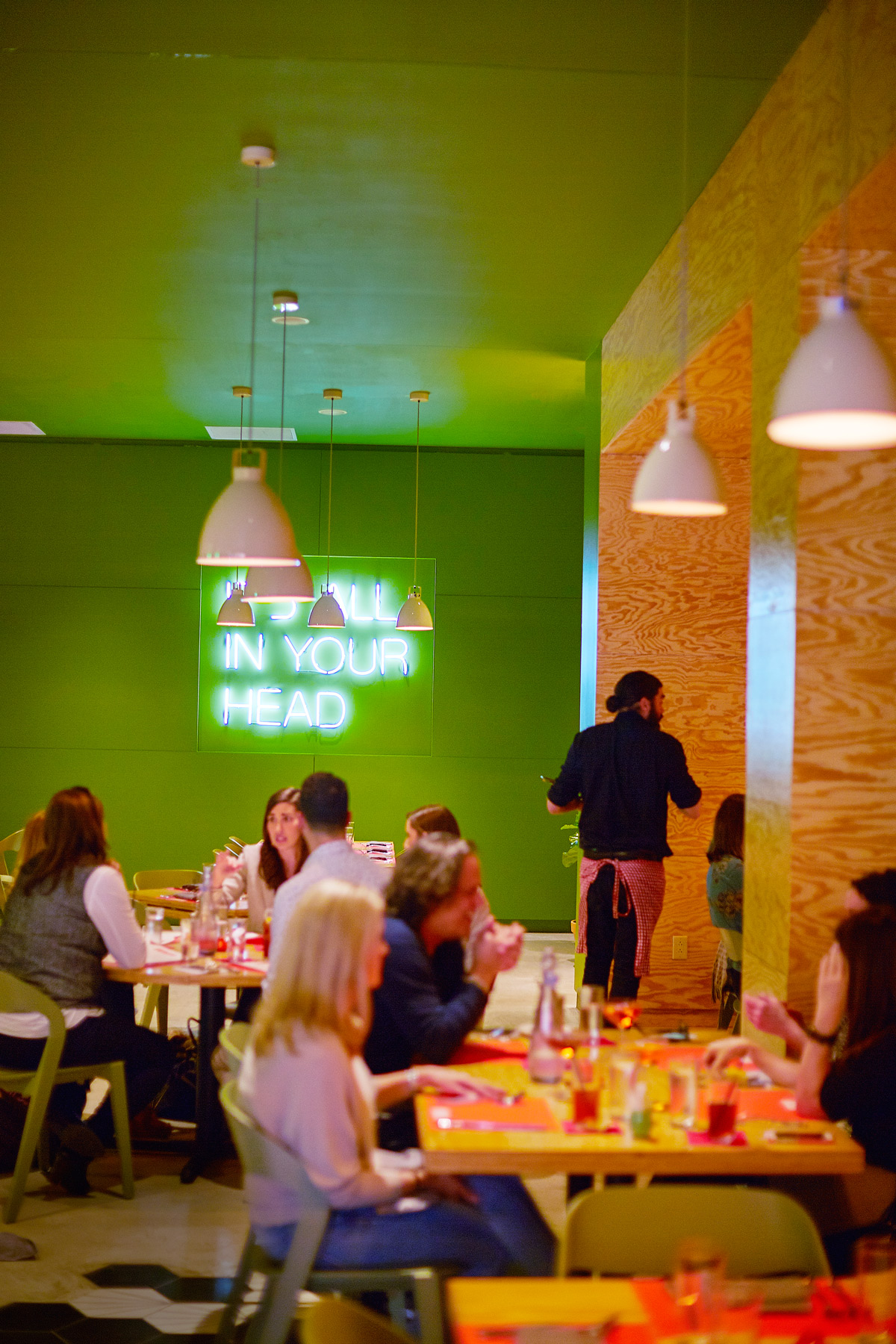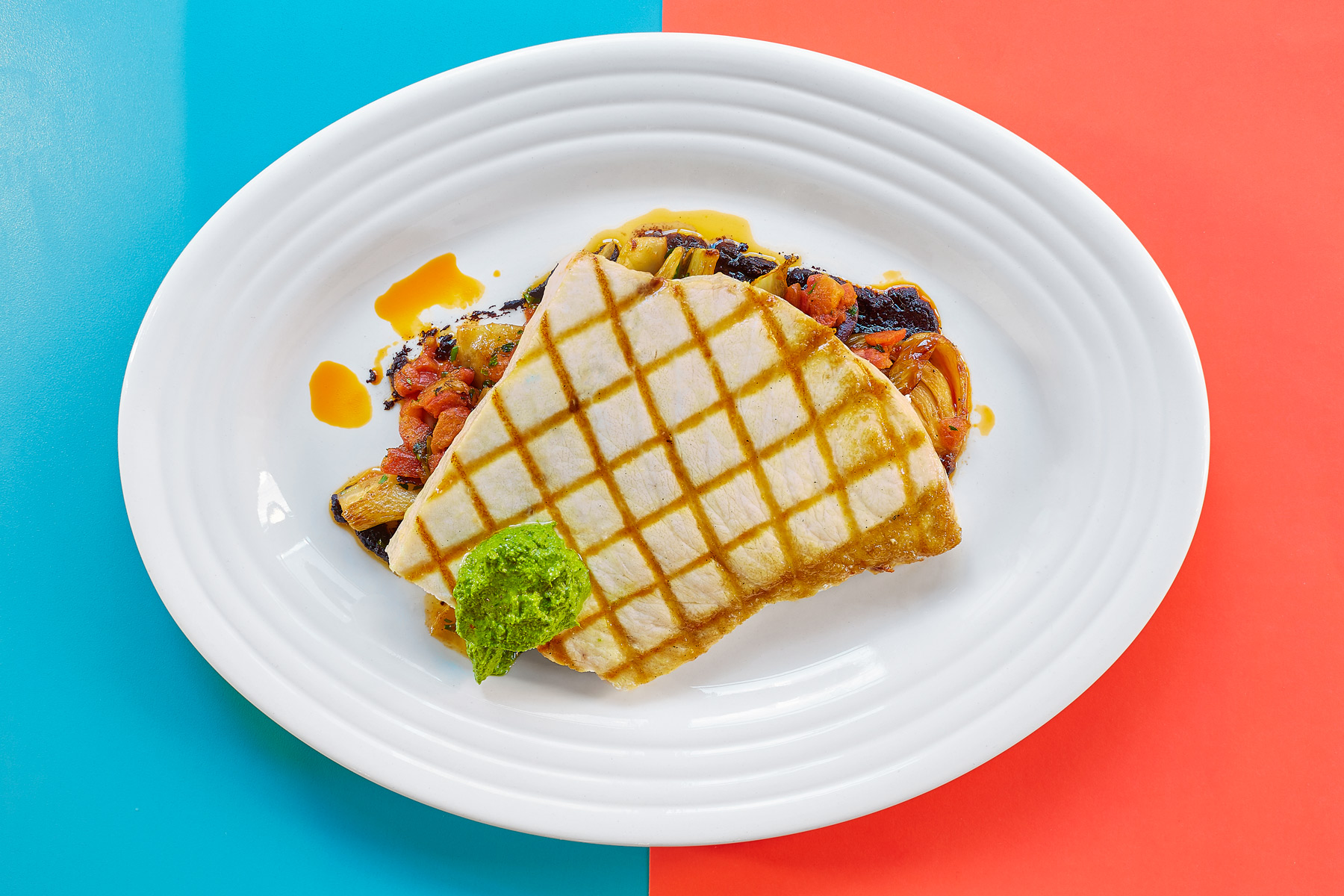From inside the bathroom, down a short hall and behind a closed door, the din from the dining room registered as a dull roar. Beyond, the interior of The Joule Hotel’s new, retro-cool restaurant, Americano, seemed designed with everything but the diner’s comfort in mind. In the room’s moody green glow, unadorned plywood alcoves annihilated auditory comfort; ditto a concrete floor. Servers threaded their way through tightly packed tables. From where I stood, the clamor of the Saturday crowd rivaled a sports arena’s. This, I thought, must be some level of hell.
Americano was conceived as a laid-back younger sibling to the by now well-established CBD Provisions. Its casual Italian fare is conducive to the atmosphere the team envisioned, an atmosphere encapsulated by Fellini’s La Dolce Vita vision of 1960s Rome, pulsing with the tumultuous, nonchalant energy of an intoxicating, hip cafe culture. “Of course, as Americans, that’s a very romantic idea we have of that era of Italian culture, of fancy-free living,” says general manager Justin Fields. “Loose, fun, loud.”

And that noise! Is it sadism or masochism, or both, that has made cacophony an accepted accessory to dining? At times that night I felt I couldn’t taste the food for the racket.
But this was a story that evolved in vignettes. After the tumult, a quieter dawn. In tranquility, I recollected the evening, replayed the dishes. Artichokes had come as crispy constellations of fried petals around tender hearts, with a light, lemony aioli. Arancini, fried rice balls, were a glorious contrast of textures—crispy outside, molten inside, and laced with porcini mushrooms. The aroma of fresh pesto stopped me mid-sentence as the plate was set down. Butternut squash tortellini were distractingly al dente, but also beautifully plated with shards of crispy speck, dabs of ricotta, and a pumpkin-seed pesto, fabulous in texture and alive with herbs.
“Italy has always been one of my countries of passion,” says chef Matt Ford, who was married in Rome.
His menu uses all of Italy as a palette, and his approach to ingredients and flavors is refreshingly down-to-earth. Starters give you quick, classic, well-priced snapshots: fried chickpeas accented with rosemary; olives with fennel pollen.
In the best tradition of rustic Italian cooking, he lets quality ingredients do good work. Castelvetrano olives are stuffed with Calabrian chile sausage and fried into a snack that is one of the best showcases I’ve had for their butteriness. Sunchoke nubs, steamed until tender then lightly fried and accented with salsa verde (I would have loved more of its parsley freshness), were allowed to be wonderfully earthy. House-made pastas are unpretentiously presented. Kale and mushroom lasagna, a stack of tender noodles layered with ricotta and bathing in a San Marzano tomato sauce, was deliciously endearing, if no looker.

Swordfish was magnificently set off by blistered tomatoes with warm notes of cinnamon, roasted fennel, and the briny brashness of Kalamata olives. Semi-boneless quail was elevated just enough with a stuffing of fennel and raisins and a sash of pancetta. A glorious salad of shaved yellow, white, and purple cauliflower was dressed simply in lemon juice and good Italian olive oil and strewn with pistachios and golden raisins, its complexity coming from color and a sneaky dash of heat.

Lemon was the only light note in an incredibly rich osso bucco my table shared three ways. A marrow bone set in the center held a tiny spoon for scooping, but the marrow had already melted into the rich embrace of the Parmesan risotto to which garlic chips gave a mellow, earthy depth. It was delicious but decadent. The dish uses beef shanks rather than veal, a choice that reflects price-point considerations. “That’s one of the problems that Charlie Palmer had in this space,” Ford says. “It became a destination place just for special occasions. If I source nice veal, it would have put that dish over the $30 range.” The meat reflects the often not-alluded-to quality of the sourcing (it’s all-natural 44 Farms Texas beef). It also makes for an undeniably less tender dish.
On a quieter night, the plywood seems friendlier. Accents of red and white are funky and fun. A sound-absorbing wall has been installed to combat the din (I noted no difference). This is not the place for an intimate date, despite votive candles set between couples sharing a plate of pappardelle Bolognese. It’s less accordion music, more shutter click, visions flashed across the retina at 24 frames per second.
The wine list is Italian, with Italian varietal cameos from Texas and California. Don’t go looking for a pinot noir. Instead, try the Tuscan Sangiovese or full-bodied Nero d’Avola from Sicily. Full bottles include less common varietals like Sagrantino. At the bar, where the staff seems adept at lip-reading, they will lead you intelligently through the registers of cocktails that feature the full panoply of Italian bitters. The Neroli Negroni on tap is assertively bitter with Rosso vermouth and Campari and aromatic from gin and orange-blossom essence. Whiskey drinkers will appreciate the smokiness of the Little Italy, which dials back the bitterness, though its Cynar (an artichoke-based liqueur) still numbs the lips. Fans of an easier cocktail will find solace in the Biscotti Bourbon or the sweet, refreshing Orzata Limonata the bartenders are fond of recommending. But Dallas seems ready for the more challenging bitter flavors so well represented on the dessert menu’s list of amari.
On my last visit, a woman asked the server to pull down the bottle of Cynar from the long bar where spigots also dispense the 10 wines on tap. “It smells like lime and cactus mixed together,” she said. A perfect description, though it’s hard to say whether anyone heard it.






